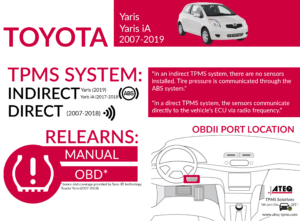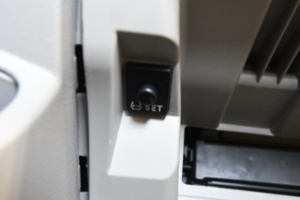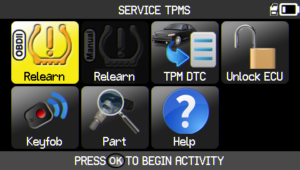Back to the news page
11.17.2019
TPMS DIAGNOSTIC INFORMATION – Toyota Yaris, Yaris iA, 2007-2019

After the TREAD Act was mandated in 2007, all vehicles manufactured in the United States beginning in 2008, must be installed with direct or indirect TPMS systems.
The Toyota Yaris and Yaris iA are installed with a direct and indirect TPMS system. Direct TPMS has TPMS sensors installed in the wheel; if one or more tires indicate low tire pressure, the TPMS sensors will transfer the information to the vehicle’s ECU. An indicator light (low-line TPMS system) or each tire pressure will show on the dash (high-line TPMS system). Indirect TPMS does not require TPMS sensors. Tire pressure is communicated through the vehicle’s ABS system and tire pressure is measured by the speed in which the wheel is spinning.
A TPMS relearn is recommended after a sensor replacement or tire rotation. When services are performed, such as a tire change or TPMS sensor replacement, in one or more tires of a Toyota Yaris and Yaris iA, a TPMS relearn must be performed to transfer the sensor information to the vehicle’s ECU.

Some Toyota models have a “SET” or “TPMS RESET” button, which is located below the steering wheel or under the glovebox. When the button is pressed, the system tries to locate the sensor ID’s that are already stored. The “SET button” can be used when performing a tire rotation that has different tire pressures in the front and rear, changing or adjusting the tire pressure, or changing tire size, or when tires are replaced.

If the “SET” button is pushed after new sensor IDs are introduced and before a relearn is performed, the ECU must be unlocked in order for the relearn procedure to work correctly. Some advanced TPMS scan tools have the capability to unlock the ECU. If your TPMS scan tool has the “UNLOCK ECU” option, the relearn procedure can be properly performed.

The image is from the ATEQ VT56 TPMS tool, showing the Toyota Yaris, Yaris iA service screen
When servicing a Toyota Yaris, perform “CHECK TPM” before working on the vehicle. Using the VT56 or VT46 brands, the tool will be able to display if the vehicle is manufactured with a direct or indirect system.
If the vehicle is an indirect system, no sensors are in the wheel, and an indirect relearn should be performed when changing air pressure, rotating tires, and replacing a TPMS sensor to turn the TPMS light off.
Use the VT56 to retrieve Toyota TPMS DTC codes by selecting the “Service” icon. After selecting the Make, Model, and Year, select the DTC code icon. Use the OBDII module to retrieve the Toyota DTC TPMS information to diagnose and service the TPMS issues determined.
Learn how to service a Toyota RAV-4 in ATEQ's newest...
The latest VT56 software update for September 2019 i...
What is the difference between direct and indirect T...